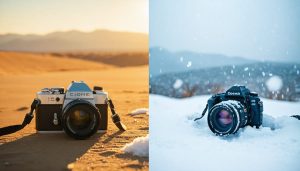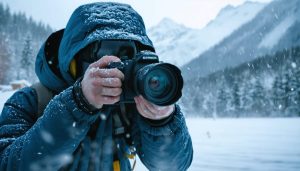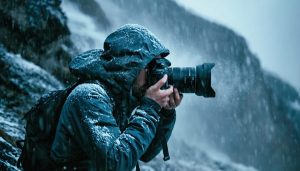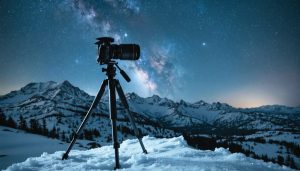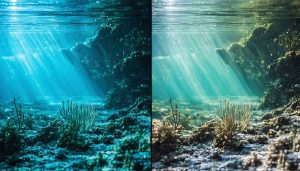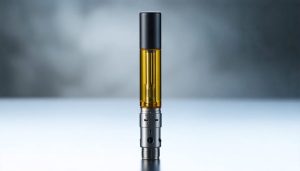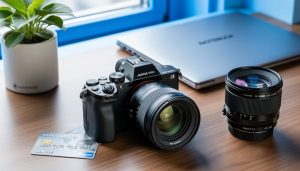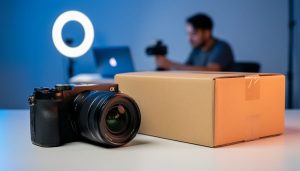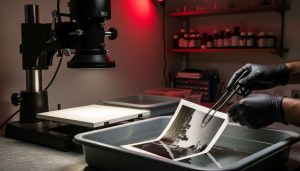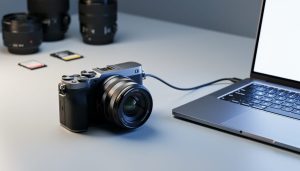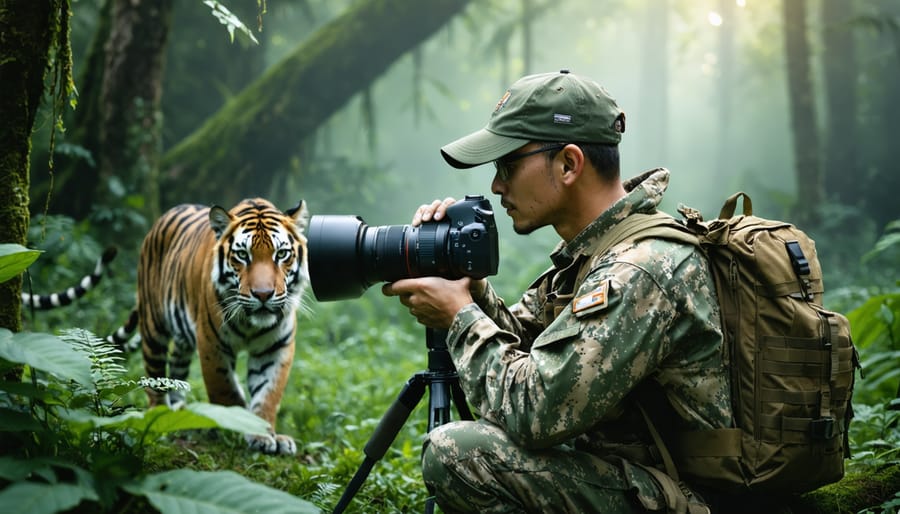
Capture wildlife behavior through patient observation and strategic positioning, mastering the delicate balance between getting close enough for impactful shots while maintaining a safe, non-disruptive distance from your subjects. Deploy professional-grade telephoto lenses (400mm or longer) paired with camera bodies offering superior low-light performance to document natural behaviors without artificial lighting. Study your subject species’ habits, patterns, and preferred habitats extensively before shooting – this knowledge forms the cornerstone of ethical wildlife photography and has shaped the evolution of conservation photography over decades. Partner with wildlife biologists and conservation organizations to ensure your work contributes meaningfully to species preservation while adhering to strict ethical guidelines that prioritize animal welfare over photographic opportunities.
Focus on telling visual stories that highlight species behaviors, environmental challenges, and conservation successes through compelling compositions that educate and inspire action. Your images serve as crucial scientific documentation, advocacy tools, and bridges between wildlife and an increasingly urbanized world that needs to understand and protect it.
Essential Gear for Conservation Photography
Camera Bodies and Weather Sealing
When photographing wildlife in their natural habitats, your camera equipment needs to be as resilient as the animals you’re documenting. Weather sealing is crucial for protecting your gear against dust, moisture, and extreme temperatures – common challenges in zoology photography. While entry-level cameras might suffice for controlled environments, serious wildlife photographers should invest in professional-grade bodies with robust weather sealing.
Cameras like the Nikon D500, Canon 7D Mark II, and Sony A9 II excel in challenging conditions, featuring extensive gaskets and seals that protect vital components. These models are specifically designed for harsh environment photography techniques and can withstand everything from tropical downpours to desert sandstorms.
Consider magnesium alloy bodies over plastic construction – they offer superior durability and better heat dissipation. Look for models with enhanced weather resistance around the battery compartment, memory card slots, and lens mount. These areas are particularly vulnerable to moisture and dust infiltration.
Remember that weather sealing is only as good as your weakest link. Always pair weather-sealed bodies with similarly protected lenses and use rain covers for additional protection during extreme conditions. While professional-grade equipment represents a significant investment, it’s essential for ensuring consistent performance and protecting your gear when working with wildlife in challenging environments.
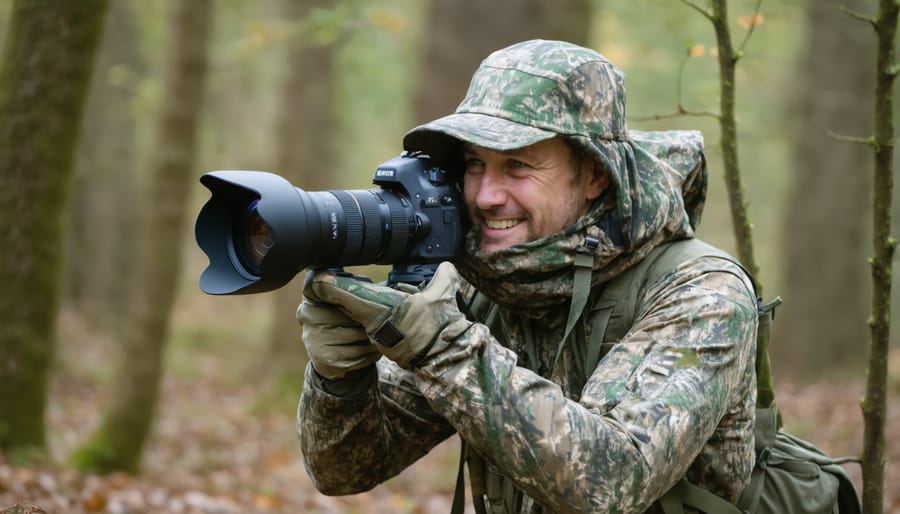
Choosing the Right Lenses
Selecting the right lens is crucial for successful wildlife photography, with telephoto lenses being your most valuable tool in the field. These powerful lenses allow you to maintain a safe, respectful distance from your subjects while still capturing intimate, detailed shots of their behavior and characteristics.
For most wildlife situations, a lens with a focal length of at least 300mm is essential. Many experienced photographers prefer lenses in the 400-600mm range, which provide excellent reach for photographing even shy or distant animals. If budget allows, consider a zoom telephoto like a 150-600mm, which offers valuable flexibility when working with subjects at varying distances.
Remember that longer focal lengths require proper technique to maximize sharpness. Always use a sturdy tripod or monopod to minimize camera shake, especially with heavier lenses. Image stabilization features, whether in-lens or in-camera, can also help achieve sharper images, particularly in challenging lighting conditions.
While super-telephoto lenses are impressive, don’t overlook the value of a versatile 70-200mm lens for larger subjects or environmental shots that show animals in their habitat. This focal range is particularly useful when photographing larger mammals or when you have the opportunity to work from a blind or hide.
When choosing your lens, consider not just focal length but also maximum aperture. Faster lenses (those with wider maximum apertures like f/2.8 or f/4) allow you to shoot in lower light conditions and achieve better background separation. However, these typically come with higher price tags and greater weight.
For those just starting out, a 70-300mm lens can be an excellent compromise, offering good reach while remaining relatively affordable and portable. As you develop your skills and identify your specific needs, you can invest in more specialized equipment that matches your shooting style and the species you most frequently photograph.
Field Techniques That Protect Habitats
Camouflage and Blind Photography
Success in wildlife photography often hinges on your ability to remain undetected while capturing authentic animal behavior. When practicing natural habitat photography, becoming virtually invisible to your subjects is essential.
The first rule of camouflage is to break up your human outline. Wear clothing that matches your environment’s colors and patterns, and avoid bright or contrasting colors that might catch an animal’s attention. A ghillie suit can be extremely effective in densely vegetated areas, while neutral-toned clothing works well in more open environments.
Portable blinds have become increasingly popular among wildlife photographers. These lightweight, portable structures can be set up quickly and provide excellent concealment. Pop-up blinds work particularly well near water sources or known feeding areas, where animals are likely to gather. For more permanent setups, consider building a dedicated hide using natural materials that blend seamlessly with the surroundings.
Remote photography has revolutionized how we capture shy or dangerous species. Camera traps equipped with motion sensors can be left in the field for days or weeks, capturing natural behaviors without human presence. When using these devices, careful placement is crucial – consider animal paths, feeding areas, and seasonal patterns.
Sound management is just as important as visual concealment. Modern cameras offer silent shooting modes, which are invaluable when photographing easily startled species. Remember to silence your phone and avoid any unnecessary movement that might create noise.
For blind photography specifically, patience is your greatest ally. It’s not unusual to spend hours waiting for the perfect moment, so bring appropriate supplies and stay comfortable without compromising your concealment. Many photographers find success by arriving before dawn and remaining still until their subjects naturally appear.
These techniques not only result in better photographs but also minimize stress on wildlife, supporting conservation efforts through responsible photography practices.
Reading Animal Behavior
Understanding animal behavior is crucial for wildlife photography, not just for capturing compelling images but also for ensuring the safety and well-being of your subjects. Animals communicate their stress and discomfort through various signals, and learning to recognize these signs is essential for ethical wildlife photography.
When photographing mammals, watch for signs like flattened ears, raised fur, or bared teeth. These indicators suggest the animal feels threatened. In birds, rapid head movements, ruffled feathers, or alarm calls signal distress. Reptiles might freeze, hiss, or display defensive postures when they feel unsafe.
Maintaining appropriate distance is vital – a good rule of thumb is to stay far enough away that the animal’s behavior doesn’t change because of your presence. Use longer lenses (400mm and above) to capture close-up shots while remaining at a safe distance. If an animal begins to show stress signals, slowly and quietly increase your distance.
Different species have varying “flight distances” – the minimum distance they’ll tolerate before fleeing. Research your subject species beforehand to understand their specific comfort zones. For example, many shorebirds become nervous when approached closer than 50 meters, while some urban wildlife might tolerate closer proximity.
Consider using portable blinds or camouflage hides to minimize your impact. These tools allow you to observe and photograph without disturbing natural behaviors. Remember that timing is crucial – many animals are most active during dawn and dusk, when they’re focused on feeding or social interactions.
Never bait or lure animals for a photo opportunity, as this can alter their natural behavior patterns and potentially create dangerous dependencies. Instead, practice patience and allow the animals to behave naturally. This approach not only produces more authentic images but also respects wildlife conservation principles.
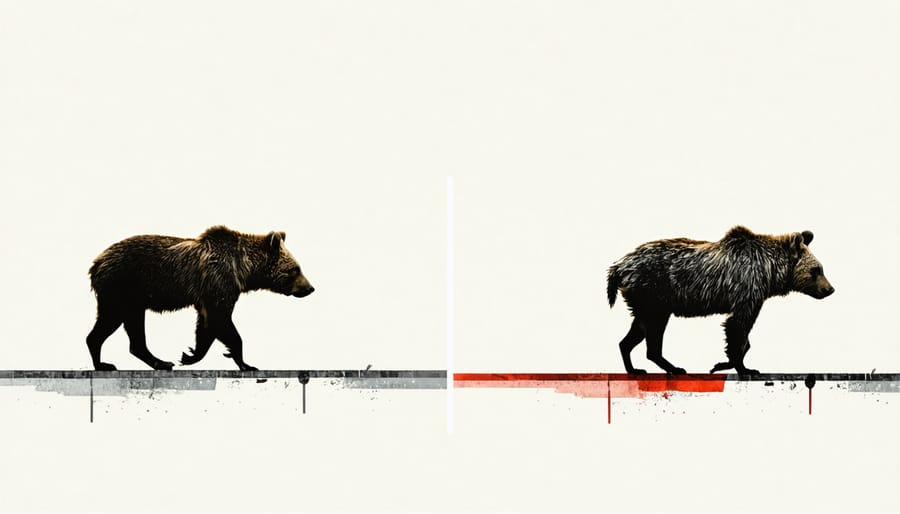
Creating Impact Through Your Images
Storytelling Through Single Shots
The art of capturing nature’s story through a single frame requires more than just technical prowess – it demands patience, observation, and an understanding of animal behavior. When approaching wildlife photography, think of each shot as a complete narrative that reveals something meaningful about the subject’s life or habitat.
Consider the environmental context as your story’s setting. Position yourself to include relevant background elements that provide insight into the animal’s ecosystem. A lion photographed against the savanna tells a different story than one framed against rocky outcrops. Look for natural framing elements like branches or rock formations that can add depth while maintaining focus on your subject.
Timing is crucial when documenting behavior. Study your subjects from a safe distance to learn their patterns and anticipate decisive moments. Watch for telltale signs that precede important behaviors – a bird adjusting its position before take-off, or a predator’s slight muscle tension before a hunt. These subtle cues can help you prepare for split-second opportunities.
Composition plays a vital role in storytelling. Use the rule of thirds to create dynamic images, but don’t be afraid to break this rule when the moment demands it. Leave space in the direction your subject is looking or moving to suggest continuation of their journey. Consider shooting from different angles – eye level shots create intimacy, while lower angles can convey power and dominance.
Remember that effective wildlife photography often means showing animals in their natural state, undisturbed by human presence. This approach not only produces more authentic images but also supports conservation efforts by documenting genuine wildlife behavior and habitat use.
Documenting Environmental Challenges
Documenting environmental challenges through zoology photography requires a delicate balance between raising awareness and avoiding sensationalism. When photographing threatened species or habitats, focus on telling the complete story – not just the concerning aspects, but also the conservation efforts and success stories that offer hope.
Approach sensitive subjects with respect and context. Rather than solely capturing distressing images of environmental degradation, consider photographing the ecosystem as a whole, showing both the challenges and the resilience of nature. For instance, when documenting habitat loss, include images of restoration projects and local conservation initiatives alongside affected areas.
Technical considerations are crucial in conservation photography. Use long lenses to maintain a safe distance from stressed animals, and avoid artificial lighting that might disturb natural behaviors. When photographing in damaged habitats, carefully choose your composition to convey the scale of the issue without overwhelming viewers.
Work closely with scientists and conservation organizations to ensure your images serve a purpose beyond shock value. Understanding the scientific context helps create more meaningful photographs that can be used for research, education, and advocacy. Document baseline conditions, changes over time, and conservation efforts to build a comprehensive visual record.
Remember to obtain necessary permits and follow local guidelines when working in protected areas. Always prioritize the welfare of your subjects over getting the perfect shot. Consider creating photo essays that combine wide environmental shots with detailed wildlife portraits to tell a more complete story of ecological challenges and potential solutions.
Finally, when sharing these images, provide accurate captions and context to help viewers understand the issues and, more importantly, how they can contribute to positive change.
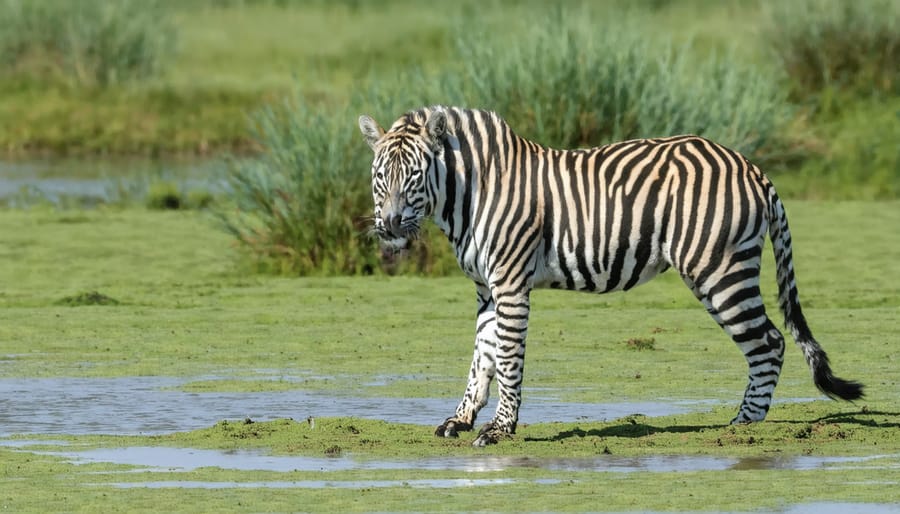
Working with Conservation Organizations
Working with conservation organizations can transform your wildlife photography from stunning captures into powerful tools for environmental advocacy. Many organizations actively seek partnerships with photographers to document their work, raise awareness, and support their conservation photography impact.
Start by researching local wildlife sanctuaries, rehabilitation centers, and conservation groups in your area. Most welcome volunteer photographers who can help document their activities and the animals in their care. When reaching out, prepare a focused portfolio highlighting your wildlife work and clearly explain how you’d like to contribute to their mission.
Remember that these organizations often have specific needs and guidelines. Some may require special permits or training before allowing you to photograph their work. Be prepared to sign agreements about image usage and follow strict protocols to ensure animal welfare remains the top priority.
To maximize your contribution:
– Offer to create photo libraries they can use for educational materials
– Document rehabilitation success stories
– Capture behind-the-scenes moments of conservation work
– Share images on social media with proper attribution and conservation messaging
– Provide high-resolution files suitable for print materials
Many organizations also appreciate photographers who can teach basic photography skills to their staff, enabling them to better document their daily work. Consider offering workshops or training sessions as part of your collaboration.
When sharing images, always include relevant conservation messages and proper credits. This helps amplify the organization’s message while building your reputation as a conservation-minded photographer. Remember that your images might be the first connection many people have with these species and their conservation challenges.
Legal and Ethical Considerations
Wildlife photography comes with significant legal and ethical responsibilities that every photographer must understand and respect. Before heading into the field, ensure you have all necessary permits and permissions, especially when working in national parks, protected areas, or private lands. Many countries require specific photography permits, and some may have restrictions on photographing certain endangered species.
Always maintain a safe distance from animals to avoid causing stress or disrupting their natural behavior. A good rule of thumb is if an animal changes its behavior because of your presence, you’re too close. Never bait or lure wildlife for a photo opportunity, as this can alter natural feeding patterns and potentially endanger both animals and humans.
Consider joining professional organizations like the North American Nature Photography Association (NANPA), which provides ethical guidelines and best practices. Their code of conduct emphasizes the importance of documenting rather than interfering with wildlife.
When sharing your images, be transparent about your methods and avoid revealing sensitive locations of endangered species or nesting sites. Some metadata should be kept private to protect vulnerable populations from poachers or excessive human intervention.
Be particularly mindful during breeding seasons and around young animals. Even temporary disturbance can have serious consequences for survival rates. Use long lenses and blinds when appropriate to minimize your impact on the environment.
Remember that getting the perfect shot should never come at the expense of an animal’s wellbeing. As wildlife photographers, we have a responsibility to serve as advocates for conservation and ethical wildlife interaction.
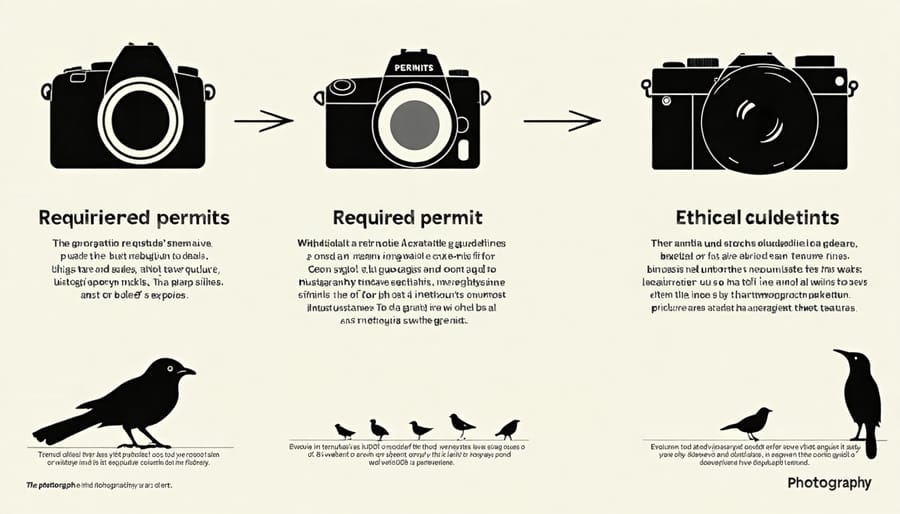
Wildlife photography is a powerful medium that bridges the gap between nature and human understanding. Through our lenses, we have the unique opportunity to showcase the beauty, behavior, and challenges faced by various species across the globe. As we’ve explored throughout this article, successful zoology photography requires a delicate balance of technical expertise, ethical awareness, and patience.
Remember that your role as a wildlife photographer extends beyond capturing stunning images. You are a storyteller, a conservationist, and an advocate for the animals you photograph. By following ethical guidelines, maintaining a safe distance, and respecting natural habitats, you contribute to the preservation of wildlife for future generations.
Whether you’re a beginner or seasoned professional, always prioritize the well-being of your subjects over getting the perfect shot. Stay informed about local regulations, join wildlife photography communities, and consider partnering with conservation organizations to make your work more impactful.
Let your passion for wildlife photography inspire others while promoting responsible practices. The images you capture today could become powerful tools for conservation tomorrow, helping to protect the incredible diversity of life on our planet.

